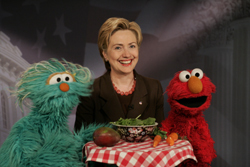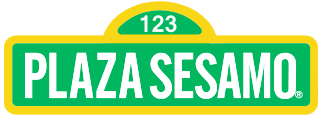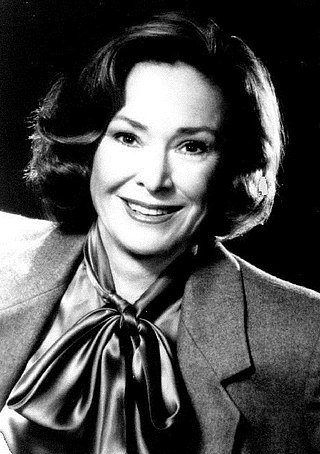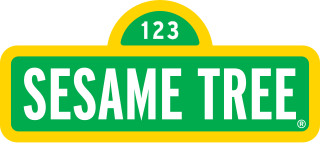
Sesame Street is an American educational children's television series that combines live-action, sketch comedy, animation and puppetry. It is produced by Sesame Workshop and was created by Joan Ganz Cooney and Lloyd Morrisett. It is known for its images communicated through the use of Jim Henson's Muppets, and includes short films, with humor and cultural references. It premiered on November 10, 1969, to positive reviews, some controversy, and high viewership. It has aired on the United States national public television provider PBS since its debut, with its first run moving to premium channel HBO on January 16, 2016, then its sister streaming service HBO Max in 2020.

Sesame Workshop, Inc. (SW), originally known as the Children's Television Workshop, Inc. (CTW), is an American nonprofit organization that has been responsible for the production of several educational children's programs—including its first and best-known, Sesame Street—that have been televised internationally. Television producer Joan Ganz Cooney and foundation executive Lloyd Morrisett developed the idea to form an organization to produce Sesame Street, a television series which would help children, especially those from low-income families, prepare for school. They spent two years, from 1966 to 1968, researching, developing, and raising money for the new series. Cooney was named as the Workshop's first executive director, which was termed "one of the most important television developments of the decade."

Elmo Monster is a red Muppet character on the children's television show Sesame Street. A furry red monster who speaks in a high-pitched falsetto voice and frequently refers to himself in the third person, he hosts the last full five-minute segment on Sesame Street, "Elmo's World", which is aimed at toddlers. He was most often puppeteered by Kevin Clash, but since Clash's resignation in late 2012, Elmo has been puppeteered by Ryan Dillon.

The preschool educational television program Sesame Street was first aired on public television stations on November 10, 1969, and reached its 54th season in 2023. The history of Sesame Street has reflected changing attitudes to developmental psychology, early childhood education, and cultural diversity. Featuring Jim Henson's Muppets, animation, live shorts, humor and celebrity appearances, it was the first television program of its kind to base its content and production values on laboratory and formative research, and the first to include a curriculum "detailed or stated in terms of measurable outcomes". Initial responses to the show included adulatory reviews, some controversy and high ratings. By its 40th anniversary in 2009, Sesame Street was broadcast in over 120 countries, and 20 independent international versions had been produced. It has won eleven Grammys and over 150 Emmys in its history—more than any other children's show.

Plaza Sésamo is the first international co-production of the educational children's television series Sesame Street. Its first season premiered in Mexico in 1972, and the last season ended in 2018 during the holiday season and the 50th anniversary of Sesame Street, but the show returned in 2020. It has also aired throughout Latin America, to a potential audience of 25 million children in 34 countries. Unlike some of the earliest co-productions, which consisted of dubbed versions of Sesame Street sketches with local language voice-overs, Plaza Sésamo along with Vila Sésamo were actual co-productions. Half of the show was adapted from the American show, and half was original material, created in Mexico by Mexican writers, performers, and producers. The first season consisted of 130 half-hour episodes. The Plaza Sésamo development process was similar to that of the American show. Its goals were developed by local experts in television, child development, and early education during curriculum seminars in Caracas, Venezuela. Sésamo's goals emphasized problem solving and reasoning, and also included perception, symbolic representation, human diversity, and the child's environment. Other goals included community cooperation, family life, nutrition, health, safety, self-esteem, and expressing emotions. Early reading skills were taught through the whole language method. The show's budget for the first and second seasons was approximately US$1.6 million.
Elmo's World is a segment that is shown at the end of the American children's television program Sesame Street which premiered on November 16, 1998, as part of a broader structural change to the show. It originally lasted fifteen minutes at the end of each episode. The segment ran until 2009, and then returned in 2017. The segment was designed to appeal to younger viewers and to increase ratings, which had fallen in the past decade. The segment is presented from the perspective of a three-year-old child as represented by its host, the Muppet Elmo, performed by Kevin Clash in the original series and Ryan Dillon in the 2017 reboot.

Joan Ganz Cooney is an American television writer and producer. She is one of the founders of Sesame Workshop, the organization famous for the creation of the children's television show Sesame Street, which was also co-created by her. Cooney grew up in Phoenix and earned a Bachelor of Arts in education from the University of Arizona in 1951. After working for the State Department in Washington, D.C., and as a journalist in Phoenix, she worked as a publicist for television and production companies in New York City. In 1961, she became interested in working for educational television, and became a documentary producer for New York's first educational TV station WNET. Many of the programs she produced won local Emmys.

Emilio Ernest Delgado was an American actor best known for his role as Luis, the Fix-it Shop owner, on the children's television series Sesame Street. He joined the cast of Sesame Street in 1971 and remained until his contract was not renewed, in late 2016, as part of Sesame Workshop's retooling of the series.
Sesame Beginnings is a line of products and a video series, spun off from the children's television series Sesame Street, featuring baby versions of the characters. The line is targeted towards infants and their parents, and products are designed to increase family interactivity.
Sherlie Mae Matthews is an American singer, songwriter and former Motown Records producer, best known as a backing vocalist for pop, R&B and rock groups from the mid-1960s to the present time.
Sesame Street international co-productions are adaptations of the American educational children's television series Sesame Street but tailored to the countries in which they are produced. Shortly after the debut of Sesame Street in the United States in 1969, television producers, teachers, and officials of several countries approached the show's producers and the executives of the Children's Television Workshop (CTW), renamed Sesame Workshop (SW) in 2000, about the possibility of airing international versions of Sesame Street. Creator Joan Ganz Cooney hired former CBS executive Michael Dann to field offers to produce versions of the show in other countries.

"Snuffy's Parents Get a Divorce" is the name of an episode on the children's television program Sesame Street. Produced in 1992, it never aired because tests showed several unintended negative effects. Sesame Street has had a history of presenting difficult topics as part of its affective curriculum goals, including death, marriage, childbirth, and disaster. Extensive research was done before these episodes were written and produced, to ascertain their focus, and after they aired, to analyze the effect they had on viewers, and that was the case for "Snuffy's Parents Get a Divorce." The show's producers had expressed a desire to produce the episode as early as 1989, and they were convinced that it was a topic they should address after the US Census Bureau reported that 40% of American children had experienced divorce.

Sesame Tree was an adaptation of the American children's television series, Sesame Street, which was made entirely in Northern Ireland. The series was produced by Belfast based production company, Sixteen South and Sesame Workshop. The first episode aired on BBC Two in Northern Ireland on 5 April 2008, with the first series subsequently airing nationwide on CBeebies in August 2008.

Children and Television: Lessons from Sesame Street (1974) is a non-fiction book written by Gerald S. Lesser, in which he describes the production of Sesame Street, and the formation and pedagogical philosophy of the Children's Television Workshop. Lesser was a professor at Harvard University, studying how social class and ethnicity interacted with school achievement and was one of the first academics in the US who researched how watching television affected children and their development. He was initially skeptical about the potential of using television as a teaching tool, but he was eventually named as the advisory board chairman of the Children's Television Workshop (CTW), the organization created to oversee the production and research of Sesame Street, and was the show's first educational director. Lesser wrote the book early in Sesame Street's history, to evaluate the show's effectiveness, to explain what its writers, researchers, and producers were attempting to do, and to respond to criticism of Sesame Street.
Gerald Samuel Lesser was an American psychologist who served on the faculty of Harvard University from 1963 until his retirement in 1998. Lesser was one of the chief advisers to the Children's Television Workshop in the development and content of the educational programming included in the children's television program Sesame Street. At Harvard, he was chair of the university's Human Development Program for 20 years, which focused on cross-cultural studies of child rearing, and studied the effects of media on young children. In 1974, he wrote Children and Television: Lessons From Sesame Street, which chronicled how Sesame Street was developed and put on the air. Lesser developed many of the research methods the CTW used throughout its history and for other TV shows. In 1968, before the debut of Sesame Street, he led a series of content seminars, an important part of the "CTW Model", which incorporated educational pedagogy and research into TV scripts and was used to develop other educational programs and organizations all over the world. He died in 2010, at the age of eighty-four, and was survived by his wife, a daughter, a son, and a grandchild.
Sesame Square is the Nigerian version of Sesame Street. It launched in 2011 as West Africa's first Sesame Street adaptation. Nigerians produce and voice the series in Standard English. It airs on the Nigerian Television Authority network.
Sesame Street is an American children's television program that is known for its use of format and structure to convey educational concepts to its preschool audience, and to help them prepare for school. It utilizes the conventions of television such as music, humor, sustained action, and a strong visual style, and combines Jim Henson's Muppets, animation, short films, humor, and cultural references. The show, which premiered in 1969, was the first to base its contents, format, and production values on laboratory and formative research. According to researchers, it was also the first to include a curriculum "detailed or stated in terms of measurable outcomes".
The children's television show Sesame Street, which premiered on public broadcasting television stations in 1969, was the first show of its kind that utilized a detailed and comprehensive educational curriculum, with specific educational goals, in its content. Its goals were garnered from in-house formative research and independent summative evaluations, and its first curriculum was created in a series of five seminars in 1968.
The children's television program Sesame Street premiered in 1969 to high ratings, positive reviews, and some controversy, which have continued during its history. Even though the show aired on only 67% of American televisions at the time of its premiere, it earned a 3.3 Nielsen rating, or 1.9 million households. By its tenth anniversary in 1979, 9 million American children under the age of six were watching Sesame Street daily. Its ratings declined in the 1990s, due to societal changes. A survey conducted in 1996 found that by the age of three, 95% of all American children had watched it. By its fortieth anniversary in 2009, it was ranked the fifteenth most popular children's show.

Sesame Street Magazine is an American monthly magazine based on the children's television series Sesame Street. The magazine features characters from the television series, and emphasizes Sesame Street's educational goals. The intended audience includes children under the age of five and their parents.










